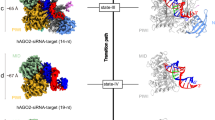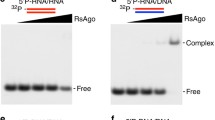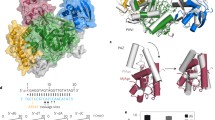Abstract
RNA interference (RNAi) is a critical cellular pathway activated by double stranded RNA and regulates the gene expression of target mRNA. During RNAi, the 3′ end of siRNA binds with the PAZ domain, followed by release and rebinding in a cyclic manner, which deemed essential for proper gene silencing. Recently, we provided the forces underlying the recognition of small interfering RNA by PAZ in a computational study based on the structure of Drosophila Argonaute 2 (Ago2) PAZ domain. We have now reanalyzed these data within the view of the new available structures from human Argonauts. While the parameters of weak binding are correlated with higher (RNAi) in the Drosophila model, a different profile is predicted with the human Ago2 PAZ domain. On the basis of the human Ago2 PAZ models, the indicators of stronger binding as the total binding energy and the free energy were associated with better RNAi efficacy. This discrepancy might be attributable to differences in the binding site topology and the difference in the conformation of the bound nucleotides.






Similar content being viewed by others
References
Tian Y, Simanshu DK, Ma JB, Patel DJ (2011) Structural basis for piRNA 2′-O-methylated 3′-end recognition by Piwi PAZ (Piwi/Argonaute/Zwille) domains. Proc Natl Acad Sci USA 108(3):903–910. doi:10.1073/pnas.1017762108
Kim VN, Han J, Siomi MC (2009) Biogenesis of small RNAs in animals. Nat Rev Mol Cell Biol 10(2):126–139. doi:10.1038/nrm2632
Frank F, Sonenberg N, Nagar B (2010) Structural basis for 5′-nucleotide base-specific recognition of guide RNA by human AGO2. Nature 465(7299):818–822. doi:10.1038/nature09039
Yan KS, Yan S, Farooq A, Han A, Zeng L, Zhou MM (2003) Structure and conserved RNA binding of the PAZ domain. Nature 426(6965):468–474. doi:10.1038/nature02129
Lingel A, Simon B, Izaurralde E, Sattler M (2004) Nucleic acid 3′-end recognition by the Argonaute2 PAZ domain. Nat Struct Mol Biol 11(6):576–577. doi:10.1038/nsmb777
Crunkhorn S (2013) Trial watch: pioneering RNAi therapy shows antitumour activity in humans. Nat Rev Drug Discov 12(3):178. doi:10.1038/nrd3962
Rao DD, Wang Z, Senzer N, Nemunaitis J (2013) RNA interference and personalized cancer therapy. Discov Med 15(81):101–110
Singhania R, Khairuddin N, Clarke D, McMillan NA (2012) RNA interference for the treatment of papillomavirus disease. Open Virol J 6:204–215. doi:10.2174/1874357901206010204
Wang W, Liu C, Wang Y, Cao L (2013) Effects of the downregulation of SnoN expression on HepG2 cell proliferation and apoptosis. Mol Med Rep 7(4):1324–1328. doi:10.3892/mmr.2013.1340
Wooddell CI, Rozema DB, Hossbach M, John M, Hamilton HL, Chu Q, Hegge JO, Klein JJ, Wakefield DH, Oropeza CE, Deckert J, Roehl I, Jahn-Hofmann K, Hadwiger P, Vornlocher HP, McLachlan A, Lewis DL (2013) Hepatocyte-targeted RNAi therapeutics for the treatment of chronic hepatitis B virus infection. Mol Ther. doi:10.1038/mt.2013.31
Li H, Zhou S, Li T, Liu Z, Wu J, Zeng G, Liu C, Gong J (2012) Suppression of BCRP expression and restoration of sensitivity to chemotherapy in multidrug-resistant HCC Cell Line HEPG2/ADM by RNA interference. Hepatogastroenterology 59(119):2238–2242. doi:10.5754/hge11781
Huang HY, Chiang BL (2009) siRNA as a therapy for asthma. Curr Opin Mol Ther 11(6):652–663
Seguin RM, Ferrari N (2009) Emerging oligonucleotide therapies for asthma and chronic obstructive pulmonary disease. Expert Opin Investig Drugs 18(10):1505–1517. doi:10.1517/13543780903179294
Presumey J, Duroux-Richard I, Courties G, Apparailly F (2010) Cationic liposome formulations for RNAi-based validation of therapeutic targets in rheumatoid arthritis. Curr Opin Mol Ther 12(3):325–330
Courties G, Presumey J, Duroux-Richard I, Jorgensen C, Apparailly F (2009) RNA interference-based gene therapy for successful treatment of rheumatoid arthritis. Expert Opin Biol Ther 9(5):535–538. doi:10.1517/14712590902926089
Li F, Mahato RI (2011) RNA interference for improving the outcome of islet transplantation. Adv Drug Deliv Rev 63(1–2):47–68. doi:10.1016/j.addr.2010.11.003
Kubowicz P, Zelaszczyk D, Pekala E (2013) RNAi in Clinical Studies. Curr Med Chem 20(14):1801–1816. doi:10.2174/09298673113209990118
Shi L, Cui S, Engel JD, Tanabe O (2013) Lysine-specific demethylase 1 is a therapeutic target for fetal hemoglobin induction. Nat Med. doi:10.1038/nm.3101
Kandeel M, Kitade Y (2013) Computational analysis of siRNA recognition by the Ago2 PAZ domain and identification of the determinants of RNA-induced gene silencing. PLoS ONE 8(2):e57140. doi:10.1371/journal.pone.0057140
Wang Y, Juranek S, Li H, Sheng G, Wardle GS, Tuschl T, Patel DJ (2009) Nucleation, propagation and cleavage of target RNAs in Ago silencing complexes. Nature 461(7265):754–761. doi:10.1038/nature08434
Gu S, Jin L, Huang Y, Zhang F, Kay MA (2012) Slicing-independent RISC activation requires the argonaute PAZ domain. Curr Biol 22(16):1536–1542. doi:10.1016/j.cub.2012.06.040
Somoza A, Terrazas M, Eritja R (2010) Modified siRNAs for the study of the PAZ domain. Chem Commun (Camb) 46(24):4270–4272. doi:10.1039/c003221b
Yoshikawa K, Ogata A, Matsuda C, Kohara M, Iba H, Kitade Y, Ueno Y (2011) Incorporation of biaryl units into the 5′ and 3′ ends of sense and antisense strands of siRNA duplexes improves strand selectivity and nuclease resistance. Bioconjug Chem 22(1):42–49. doi:10.1021/bc100301w
Gong W, Desaulniers JP (2012) Gene-silencing properties of siRNAs that contain internal amide-bond linkages. Bioorg Med Chem Lett 22(22):6934–6937. doi:10.1016/j.bmcl.2012.09.009
Avino A, Ocampo SM, Perales JC, Eritja R (2012) Synthesis and in vitro inhibition properties of siRNA conjugates carrying acridine and quindoline moieties. Chem Biodivers 9(3):557–566. doi:10.1002/cbdv.201100321
Zeng L, Zhang Q, Yan K, Zhou MM (2011) Structural insights into piRNA recognition by the human PIWI-like 1 PAZ domain. Proteins 79(6):2004–2009. doi:10.1002/prot.23003
Elkayam E, Kuhn CD, Tocilj A, Haase AD, Greene EM, Hannon GJ, Joshua-Tor L (2012) The structure of human argonaute-2 in complex with miR-20a. Cell 150(1):100–110. doi:10.1016/j.cell.2012.05.017
Schirle NT, MacRae IJ (2012) The crystal structure of human Argonaute2. Science 336(6084):1037–1040. doi:10.1126/science.1221551
Taniho K, Nakashima R, Kandeel M, Kitamura Y, Kitade Y (2012) Synthesis and biological properties of chemically modified siRNAs bearing 1-deoxy-D-ribofuranose in their 3′-overhang region. Bioorg Med Chem Lett 22(7):2518–2521. doi:10.1016/j.bmcl.2012.01.132
Kuboe S, Yoda M, Ogata A, Kitade Y, Tomari Y, Ueno Y (2010) Diazirine-containing RNA photocrosslinking probes for the study of siRNA-protein interactions. Chem Commun (Camb) 46(39):7367–7369. doi:10.1039/c0cc02450c
Ueno Y, Komatsuzaki S, Takasu K, Kitamura Y, Kitade Y (2009) Synthesis and properties of oligodeoxynucleotides containing biaryl units. Nucleic Acids Symp Ser (Oxf) 53:27–28. doi:10.1093/nass/nrp014
Ueno Y, Watanabe Y, Shibata A, Yoshikawa K, Takano T, Kohara M, Kitade Y (2009) Synthesis of nuclease-resistant siRNAs possessing universal overhangs. Bioorg Med Chem 17(5):1974–1981. doi:10.1016/j.bmc.2009.01.033
Ueno Y, Inoue T, Yoshida M, Yoshikawa K, Shibata A, Kitamura Y, Kitade Y (2008) Synthesis of nuclease-resistant siRNAs possessing benzene-phosphate backbones in their 3′-overhang regions. Bioorg Med Chem Lett 18(19):5194–5196. doi:10.1016/j.bmcl.2008.08.086
Ueno Y, Kawada K, Shibata A, Yoshikawa K, Wataya Y, Kitade Y (2008) Synthesis and silencing properties of siRNAs possessing lipophilic groups at their 3′-termini. Nucleic Acids Symp Ser (Oxf) 52:503–504. doi:10.1093/nass/nrn255
Ueno Y, Kato T, Sato K, Ito Y, Yoshida M, Inoue T, Shibata A, Ebihara M, Kitade Y (2005) Synthesis and properties of nucleic acid analogues consisting of a benzene-phosphate backbone. J Org Chem 70(20):7925–7935. doi:10.1021/jo050635m
Hsu KC, Chen YF, Lin SR, Yang JM (2011) iGEMDOCK: a graphical environment of enhancing GEMDOCK using pharmacological interactions and post-screening analysis. BMC Bioinformatics 12(Suppl 1):S33. doi:10.1186/1471210512S1S33
Li Y, Frenz CM, Li Z, Chen M, Wang Y, Li F, Luo C, Sun J, Bohlin L, Yang H, Wang C (2011) Virtual and in vitro bioassay screening of phytochemical inhibitors from flavonoids and isoflavones against xanthine oxidase and cyclooxygenase-2 for gout treatment. Chem Biol Drug Des. doi:10.1111/j.17470285.2011.01248.x
Bikadi Z, Hazai E (2009) Application of the PM6 semi-empirical method to modeling proteins enhances docking accuracy of AutoDock. J Cheminform 1:15. doi:10.1186/17582946115
Morris GM, Goodsell DS, Halliday RS, Huey R, Hart WE, Belew RK, Olson AJ (1998) Automated docking using a Lamarckian genetic algorithm and an empirical binding free energy function. J Comput Chem 19(14):1639–1662. doi:10.1002/(sici)1096987x(19981115)19:14<1639:aidjcc10>3.0.co;2b
Song JJ, Liu J, Tolia NH, Schneiderman J, Smith SK, Martienssen RA, Hannon GJ, Joshua-Tor L (2003) The crystal structure of the Argonaute2 PAZ domain reveals an RNA binding motif in RNAi effector complexes. Nat Struct Biol 10(12):1026–1032. doi:10.1038/nsb1016
Lingel A, Simon B, Izaurralde E, Sattler M (2003) Structure and nucleic-acid binding of the Drosophila Argonaute 2 PAZ domain. Nature 426(6965):465–469. doi:10.1038/nature02123
Tomari Y, Zamore PD (2005) Perspective: machines for RNAi. Genes Dev 19(5):517–529. doi:10.1101/gad.1284105
Lee-Fowler TM, Guntur V, Dodam J, Cohn LA, DeClue AE, Reinero CR (2012) The tyrosine kinase inhibitor masitinib blunts airway inflammation and improves associated lung mechanics in a feline model of chronic allergic asthma. Int Arch Allergy Immunol 158(4):369–374. doi:10.1159/000335122
Acknowledgments
Research support from Ministry of Education, Culture, Sports, Science and Technology (MEXT) and Grants-in-Aid for scientific Research (Grant No. 24390025) from the Japan Society for the Promotion of Science (JSPS).The authors provide that “The funders had no role in study design, data collection and analysis, decision to publish, or preparation of the manuscript”.
Author information
Authors and Affiliations
Corresponding authors
Rights and permissions
About this article
Cite this article
Kandeel, M., Kitade, Y. In silico molecular docking analysis of the human Argonaute 2 PAZ domain reveals insights into RNA interference. J Comput Aided Mol Des 27, 605–614 (2013). https://doi.org/10.1007/s10822-013-9665-3
Received:
Accepted:
Published:
Issue Date:
DOI: https://doi.org/10.1007/s10822-013-9665-3




